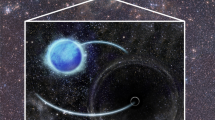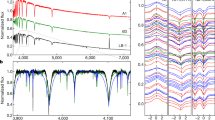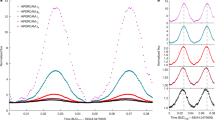Abstract
Stellar-mass black holes have all been discovered through X-ray emission, which arises from the accretion of gas from their binary companions (this gas is either stripped from low-mass stars or supplied as winds from massive ones). Binary evolution models also predict the existence of black holes accreting from the equatorial envelope of rapidly spinning Be-type stars1,2,3 (stars of the Be type are hot blue irregular variables showing characteristic spectral emission lines of hydrogen). Of the approximately 80 Be X-ray binaries known in the Galaxy, however, only pulsating neutron stars have been found as companions2,3,4. A black hole was formally allowed as a solution for the companion to the Be star MWC 656 (ref. 5; also known as HD 215227), although that conclusion was based on a single radial velocity curve of the Be star, a mistaken spectral classification6 and rough estimates of the inclination angle. Here we report observations of an accretion disk line mirroring the orbit of MWC 656. This, together with an improved radial velocity curve of the Be star through fitting sharp Fe ii profiles from the equatorial disk, and a refined Be classification (to that of a B1.5–B2 III star), indicates that a black hole of 3.8 to 6.9 solar masses orbits MWC 656, the candidate counterpart of the γ-ray source AGL J2241+4454 (refs 5, 6). The black hole is X-ray quiescent and fed by a radiatively inefficient accretion flow giving a luminosity less than 1.6 × 10−7 times the Eddington luminosity. This implies that Be binaries with black-hole companions are difficult to detect in conventional X-ray surveys.
This is a preview of subscription content, access via your institution
Access options
Subscribe to this journal
Receive 51 print issues and online access
$199.00 per year
only $3.90 per issue
Buy this article
- Purchase on Springer Link
- Instant access to full article PDF
Prices may be subject to local taxes which are calculated during checkout



Similar content being viewed by others
References
Raguzova, N. V. & Lipunov, V. M. The evolutionary evidence for Be/black hole binaries. Astron. Astrophys. 349, 505–510 (1999)
Zhang, F., Li, X.-D. & Wang, Z.-R. Where are the Be/black hole binaries? Astrophys. J. 603, 663–668 (2004)
Belczynski, K. & Ziolkówski, J. On the apparent lack of Be X-ray binaries with black holes. Astrophys. J. 707, 870–877 (2009)
Ziólkowski, J. & Belczynski, K. On the apparent lack of Be X-ray binaries with black holes in the Galaxy and in the Magellanic Clouds. IAU Symp. 275, 329–330 (2011)
Casares, J. et al. On the binary nature of the γ-ray sources AGL J2241+4454 ( = MWC 656) and HESS J0632+057 ( = MWC 148). Mon. Not. R. Astron. Soc. 421, 1103–1112 (2012)
Williams, S. J. et al. The Be star HD 215227: a candidate gamma-ray binary. Astrophys. J. 723, L93–L97 (2010)
Reig, P. Be/X-ray binaries. Astrophys. Space Sci. 332, 1–29 (2011)
Okazaki, A. T. & Negueruela, I. A natural explanation for periodic X-ray outbursts in Be/X-ray binaries. Astron. Astrophys. 377, 161–174 (2001)
Lucarelli, F. et al. AGILE detection of the new unidentified gamma-ray source AGL J2241+4454. Astron. Telegr. 2761, 1 (2010)
Ballereau, D., Chauville, J. & Zorec, J. High-resolution spectroscopy of southern and equatorial Be stars: flux excess at λ4471 Å. Astron. Astrophys. Suppl. Ser. 111, 423–455 (1995)
Smak, J. On the rotational velocities of gaseous rings in close binary systems. Acta Astronomica 19, 155–164 (1969)
Etzel, P. SBOP: Spectroscopic Binary Orbit Program (San Diego State Univ., 2004)
Hanuschik, R. W. On the structure of Be star disks. Astron. Astrophys. 308, 170–179 (1996)
Arias, M. L. et al. Fe II emission lines in Be stars. I. Empirical diagnostic of physical conditions in the circumstellar discs. Astron. Astrophys. 460, 821–829 (2006)
Peters, G. J., Pewett, T. D., Gies, D. R., Touhami, Y. N. & Grundstrom, E. D. Far-ultraviolet detection of the suspected subdwarf companion to the Be star 59 Cygni. Astrophys. J. 765, 2–9 (2013)
Garcia, M. R. et al. New evidence for black hole event horizons from Chandra. Astrophys. J. 553, L47–L50 (2001)
Esin, A. A., McClintock, J. E. & Narayan, R. Advection-dominated accretion and the spectral states of black hole X-ray binaries: application to Nova Muscae 1991. Astrophys. J. 489, 865–889 (1997)
Menou, K., Narayan, R. & Lasota, J.-P. A population of faint nontransient low-mass black hole binaries. Astrophys. J. 513, 811–826 (1999)
Coriat, M., Fender, R. P. & Dubus, G. Revisiting a fundamental test of the disc instability model for X-ray binaries. Mon. Not. R. Astron. Soc. 424, 1991–2001 (2012)
Linden, T., Valsecchi, F. & Kalogera, V. On the rarity of X-ray binaries with naked helium donors. Astrophys. J. 748, 114–121 (2012)
Schneider, D. P. & Young, P. The magnetic maw of 2A 0311-227. Astrophys. J. 238, 946–954 (1980)
Smak, J. On the S-wave components of the emission lines in the spectra of cataclysmic variables. Acta Astronomica 35, 351–367 (1985)
Shafter, A. W., Szkody, P. & Thorstensen, J. R. X-ray and optical observations of the ultrashort period dwarf nova SW Ursae Majoris — a likely new DQ Herculis star. Astrophys. J. 308, 765–780 (1986)
Paredes-Fortuny, X., Ribó, M., Fors, O. & Núñez, J. Optical photometric monitoring of gamma-ray binaries. Am. Inst. Phys. Conf. Ser. 1505, 390–393 (2012)
Gray, D. F. The Observations and Analysis of Stellar Photospheres (CUP 20, Wiley-Interscience, 1992)
Ryans, R. S. et al. Macroturbulent and rotational broadening in the spectra of B-type supergiants. Astron. Astrophys. 336, 577–586 (2002)
Abt, H. A., Levato, H. & Grosso, M. Rotational velocities of B stars. Astrophys. J. 573, 359–365 (2002)
Howarth, I. D. & Smith, K. C. Rotational mixing in early-type main-sequence stars. Mon. Not. R. Astron. Soc. 327, 353–368 (2001)
Walborn, N. R. et al. Further results from the Galactic O-star spectroscopic survey: rapidly rotating late ON giants. Astron. J. 142, 150–156 (2011)
Przybilla, N., Firnstein, M., Nieva, M. F., Meynet, G. & Maeder, A. Mixing of CNO-cycled matter in massive stars. Astron. Astrophys. 517, A38–A43 (2010)
Straižys, V. & Kuriliene, G. Fundamental stellar parameters derived from the evolutionary tracks. Astrophys. Space Sci. 80, 353–368 (1981)
Pavlovski, K. et al. Chemical evolution of high-mass stars in close binaries — II. The evolved component of the eclipsing binary V380 Cygni. Mon. Not. R. Astron. Soc. 400, 791–804 (2009)
Torres, G., Andersen, J. & Giménez, A. Accurate masses and radii of normal stars: modern results and applications. Astron. Astrophys. Rev. 18, 67–126 (2010)
Harmanec, P. Stellar masses and radii based on modern binary data. Bull. Astron. Inst. Czech. 39, 329–345 (1988)
Negueruela, I. et al. Astrophysical parameters of LS 2883 and implications for the PSR B1259-63 gamma-ray binary. Astrophys. J. 732, L11–L15 (2011)
Thompson, G. I. et al. Catalogue of Stellar Ultraviolet Fluxes. A Compilation of Absolute Stellar Fluxes Measured by the Sky Survey Telescope (S2/68) Aboard the ESRO Satellite TD-1 (Science Research Council, UK, 1978)
Merrill, P. W. & Burwell, C. G. Supplement to the Mount Wilson catalogue and bibliography of stars of classes B and A whose spectra have bright hydrogen lines. Astrophys. J. 98, 153–184 (1943)
Hubeny, I. & Lanz, T. NLTE line blanketed model atmospheres of hot stars. I. Hybrid complete linearization/accelerated lambda iteration method. Astrophys. J. 439, 875–904 (1995)
Puls, J. et al. Atmospheric NLTE-models for the spectroscopic analysis of blue stars with winds. II. Line-blanketed models. Astron. Astrophys. 435, 669–698 (2005)
Nicolet, B. Catalogue of homogeneous data in the UBV photoelectric photometric system. Astron. Astrophys. Suppl. Ser. 34, 1–49 (1978)
Plotkin, R. M., Gallo, E. & Jonker, P. G. The X-ray spectral evolution of galactic black hole X-ray binaries toward quiescence. Astrophys. J. 773, 59–74 (2013)
Bohlin, R. C., Savage, B. D. & Drake, J. F. A survey of interstellar H I from L-alpha absorption measurements. II. Astrophys. J. 224, 132–134 (1978)
Mirabel, I. F. Gamma-ray binaries revealed. Science 335, 175–176 (2012)
Albert, J. et al. Very high energy gamma-ray radiation from the stellar mass black hole binary Cygnus X-1. Astrophys. J. 665, L51–L54 (2007)
Sabatini, S. et al. Gamma-ray observations of Cygnus X-1 above 100 MeV in the hard and soft states. Astrophys. J. 766, 83–97 (2013)
Lipunov, V. M., Postnov, K. A., Prokhorov, M. E. & Osminkin, E. Yu. Binary radiopulsars with black holes. Astrophys. J. 423, L121–L124 (1994)
Schaller, G., Schaerer, D., Meynet, G. & Maeder, A. New grids of stellar models from 0.8 to 120 solar masses at Z = 0.020 and Z = 0.001. Astron. Astrophys. 96 (suppl.). 269–331 (1992)
Woosley, S. E. & Weaver, T. A. The evolution and explosion of massive stars. II. Astrophys. J. Suppl. Ser. 101, 181–235 (1995)
Boersma, J. Mathematical theory of the two-body problem with one of the masses decreasing with time. Bull. Astron. Inst. Neth. 15, 291–301 (1961)
Narayan, R., Piran, T. & Shemi, A. Neutron star and black hole binaries in the Galaxy. Astrophys. J. 379, L17–L20 (1991)
Portegies Zwart, S. F. & Yungelson, L. R. Formation and evolution of binary neutron stars. Astron. Astrophys. 332, 173–188 (1998)
Belczynski, K., Kalogera, V. & Bulik, T. A Comprehensive study of binary compact objects as gravitational wave sources: evolutionary channels, rates, and physical properties. Astrophys. J. 572, 407–431 (2002)
Belczynski, K. et al. Cyg X-3: a galactic double black hole or black-hole-neutron-star progenitor. Astrophys. J. 764, 96–102 (2013)
Lesh, J. R. The kinematics of the Gould Belt: an expanding group? Astrophys. J. 17 (suppl.). 371–444 (1969)
Acknowledgements
We thank T. Maccarone and P. Charles for comments on the paper. This work made use of the molly software package developed by T. R. Marsh. The Liverpool telescope and the Mercator telescope are operated on the island of La Palma by the Liverpool John Moores University and the University of Leuven/Observatory of Geneva, respectively, in the Spanish Observatorio del Roque de los Muchachos of the Instituto de Astrofísica de Canarias. The Liverpool telescope is funded by the UK Science and Technology Facilities Council. This research was supported by the Spanish MINECO and FEDER under grants AYA2010-18080, AYA2010-21782-C03-01, AYA2010-21967-C05-04/05, AYA2012-39364-C02-01/02, AYA2012-39612-C03-01, FPA2010-22056-C06-02 and SEV2011-0187-01; it was also funded by grant PID 2010119 from the Gobierno de Canarias. J.M.P. acknowledges financial support from ICREA Academia.
Author information
Authors and Affiliations
Contributions
J.C. performed the radial velocity analysis of the spectra and wrote the paper. I.N. obtained the Mercator spectrum and contributed to the interpretation of the data. I.R. computed the eccentric orbital fits to the radial velocity curves. M.R. calculated the distance and X-ray luminosity, and contributed to the interpretation of the data. J.M.P. also contributed to the interpretation of the data. A.H. computed the rotational broadening of the star and, together with I.N., performed the spectral calibration of the star. S.S-D. observed the standard stars and reduced the Mercator spectra. J.M.P. and M.R. assisted in writing the section on γ-ray binaries in Methods.
Corresponding author
Ethics declarations
Competing interests
The authors declare no competing financial interests.
Extended data figures and tables
Extended Data Figure 1 Time evolution of the He ii 4,686 Å emission line in MWC 656.
a, Radial velocities obtained from single Gaussian fits to the line profile. The best fitting sine wave, with a period of 59.5 days, is overplotted. Maximum velocity occurs at HJD 2455722.2 or photometric phase 0.06. b, Equivalent width (EW) as a function of time. We used the convention of positive equivalent widths for emission lines. Error bars, 1 s.d.
Extended Data Figure 2 Diagnostic diagram for the He ii 4,686 Å line in MWC 656.
It has been computed using the double-Gaussian technique with a Gaussian width equal to the instrumental resolution full-width at half-maximum, 55 km s−1. The vertical dotted line indicates the Gaussian separation for which the continuum noise starts to dominate. Error bars, 1 s.d. Panels display the evolution of the sine wave fitting parameters with Gaussian separation a. From top to bottom: the systemic velocity γ, the sine wave ϕ0 phase, the velocity semiamplitude K and the control parameter σ(K)/K.
Extended Data Figure 3 Classification spectrum of the Be star MWC 656.
From top to bottom, spectra of MWC 656 and the MK standards HD 214993 (B1.5 III) and HD 35468 (B2 III) (ref. 54). The standards have been artificially broadened by 330 km s−1 to mimic the rotational broadening of MWC 656.
Rights and permissions
About this article
Cite this article
Casares, J., Negueruela, I., Ribó, M. et al. A Be-type star with a black-hole companion. Nature 505, 378–381 (2014). https://doi.org/10.1038/nature12916
Received:
Accepted:
Published:
Issue Date:
DOI: https://doi.org/10.1038/nature12916
This article is cited by
-
Hints of the photometric period in radial velocity data of the X-ray binary HD 3191 with the Joan Oró telescope
Astrophysics and Space Science (2023)
-
The nearest neutron star candidate in a binary revealed by optical time-domain surveys
Science China Physics, Mechanics & Astronomy (2023)
-
Science with the 2.5-meter Wide Field Survey Telescope (WFST)
Science China Physics, Mechanics & Astronomy (2023)
Comments
By submitting a comment you agree to abide by our Terms and Community Guidelines. If you find something abusive or that does not comply with our terms or guidelines please flag it as inappropriate.



